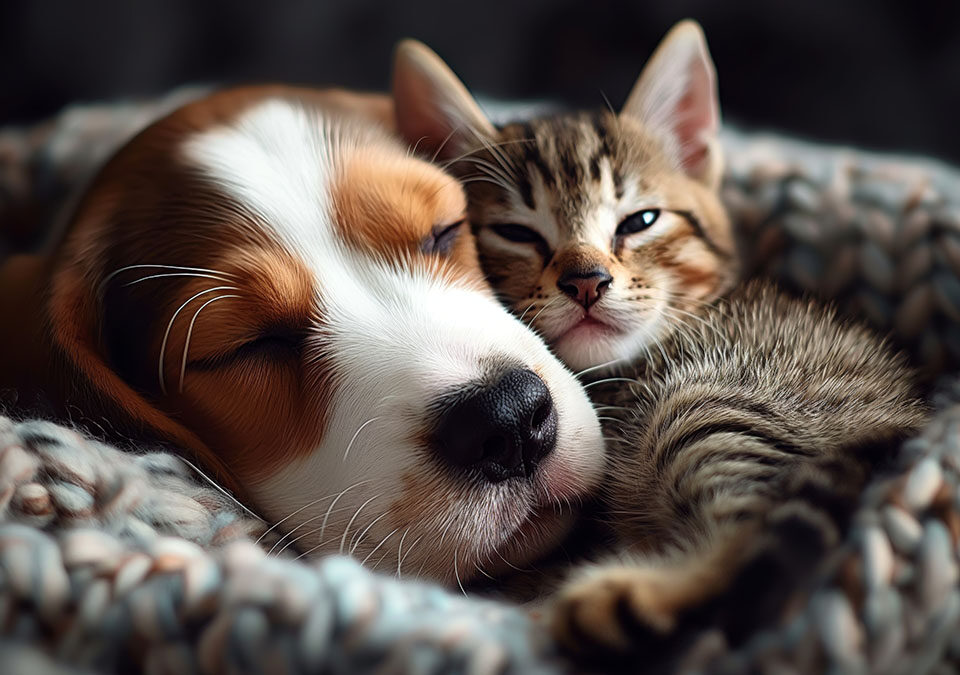
What it Means To Be An Animal Advocate
February 22, 2023
Suncoast Pet Magazine Shines a Spotlight on Burns Court Veterinary Care
January 26, 2024Unleashing the power of your pets starts with care.
If you’re bringing home your new furry family member for the first time, it’s natural to get lost in the excitement of preparing for their arrival and welcoming them home. With lots to do to prepare, it can be easy to forget the importance of prioritizing their health. In addition to the basics of food, water, and shelter, here are specific ways to be a Prime Pet Parent.
1. Prevention
Heartworm Prevention
Heartworm prevention is recommended for both dogs and cats. Heartworms are easily transmissible through mosquitoes, making mosquito season a dangerous time for animals that are not up-to-date on their preventative medication. Even completely indoor pets are susceptible to mosquito bites and thus the transmission of heartworms. Unfortunately, for those Pet Parents who live in the southeastern United States, it’s pretty much mosquito season year-round, given our climate.
Dogs are natural hosts for heartworms, meaning juvenile worms can survive and mature into adults inside the dog. Symptoms do not always appear early on in the disease process, and if they do, it may be “a mild persistent cough, reluctance to exercise, fatigue after moderate activity, decreased appetite, or weight loss”. As the worms grow in size and number, the severity of symptoms is likely to increase. Without medical intervention early on, or quick surgical removal later in the disease process, end-stage Heartworm disease is fatal.
In contrast, cats are not natural hosts for heartworms, meaning adult worms do not thrive in cats, and typically die soon after reaching maturity. For all the cat parents out there, you might be thinking “That’s great! My cat will take care of the heart worms themself without ever needing medication!” However, this is not the case. In the cat, the problem comes when those dead adult worms continue to circulate within the cardiovascular system and end up getting stuck in tiny capillary beds in the lungs. At this point, the cat’s immune system strongly reacts to the dead worms and can cause a serious inflammatory reaction, typically resulting in asthma-like symptoms (coughing, wheezing, etc.). Additionally, immature worms can still cause significant, irreversible damage to cats. Oftentimes, the first sign may be sudden collapse or death of a cat.
And with few adult heartworms actually living in a cat, it can make detecting them very difficult (not impossible, but difficult). Preventative medication and early detection are the only ways to protect cats from heartworms.
The American Heartworm Society recommends that you “think 12”: (1) get your pet tested every 12 months for heartworm and (2) give your pet heartworm prevention 12 months a year. Testing for heartworms at the vet and preventative medication are the best ways to avoid the deadly dangers of heartworm disease. If you have any concerns or suspicions, a trip to the vet is the quickest way to get answers and peace of mind.
Flea and Tick Prevention
Fleas and ticks, just like heartworms, can potentially be deadly for our furry friends. Especially if you live in the southeast United States, flea and tick prevention is something a Pet Parent can’t ignore! Unfortunately, in warmer climates, it never truly gets cold enough to kill off all fleas and ticks, so you should be using preventative care for your pets year round.
Did you know that fleas can carry tapeworms?
Tapeworms can cause gastrointestinal problems for your pet. Also, be aware that tapeworms are zoonotic, which means humans can be infected by them as well. Please consider this when creating a prevention plan with your veterinarian.
Flea infestations can be critically dangerous in young animals. A flea infestation can cause life-threatening anemias in baby animals because they have less blood mass. Make sure to have routine parasite testing performed on your puppies and kittens.
And fleas can be present anywhere and don’t have any boundaries. If your dog is “completely indoors but hangs out on the lanai,” your pup is at risk. If your dog goes outside at all, your dog needs to be protected from fleas.
Cats are a little bit of a different story. Unless your cat is infested with fleas, you likely won’t see any fleas on a cat. Cats are great self-groomers and typically lick off and swallow fleas before you even know they are there. And besides transmitting parasites, fleas can also cause allergic skin reactions in some cats and dogs.
Ticks
Ticks, a much larger issue if you live in a wooded area, can carry many diseases. Some of these diseases can even affect us, such as Lyme disease, Rocky Mountain Spotted Fever, Ehrlichia, and so on. While dogs and cats can’t directly transmit these diseases to humans, infected ticks can also bite and infect humans. And initially, ticks are small enough that you won’t always feel them, so always play it safe and examine your pet and yourself.
Your pet relies on you to pay attention and take that extra five minutes to check to see if you can find any fleas or ticks. Fleas and ticks are not 100% avoidable, but they are 100% treatable given enough time to address the problem.
2. Mental stimulation
Like humans, pets can become sad, anxious, or drained when they lack mental stimulation. When boredom creeps in, your pet may start acting out. Mental stimulation is crucial to giving pets a sense of meaning and accomplishment, thus improving their behavior and creating happier fur friends. In addition to the plethora of toys on the market to aimed at challenging Fido, here are other easy ways to stimulate them.
Stop and Smell the Roses
Sensory exploration is an easy way to mentally stimulate your pet. If letting them off the leash to roam is not an option, consider slowing down your walks and giving them the freedom to sniff before rushing to the next block. There are constantly new smells, even in the same neighborhood, and curiosity is a great way to challenge their minds.
Trick for Treat
Does your dog know the basic commands like sit, stay, and shake? Having the patience to teach your pup new tricks is a special way to strengthen your bond, mentally stimulate them, AND boost their confidence. With so much to learn, it is never too late to start or add to their repertoire of impressive tricks.
Trained dogs also have better impulse control and manners, making them the star of the show when around new friends (human and animal alike).
And yes, old dogs can learn new tricks!
Tonight, We Feast
Feeding times are another great way to incorporate mental stimulation. This dispenser slowly shakes out food as the dog works for it. A fun shaped ice cube tray, a cupcake tin, or “food puzzles” are other resources to consider to change a dog’s eating habits. This keeps your pet entertained for much longer than a traditional bowl and can also help them slow down when eating, aiding in appropriate digestion.
3. Bloodwork
Taking your pet(s) to the vet for a comprehensive physical exam and routine bloodwork is the best way to create a customized plan of action for your pet. Even if your pet seems okay, bloodwork is still recommended to create a baseline assessment of their health, track changes, and provide preventative care. Wellness blood work can detect changes in your pet’s health, often well before they show any outward signs of illness. This is extremely important as the prognosis for any given disease is almost always better the earlier the disease is discovered. The sooner your veterinarian knows about the presence of a disease affecting your pet, the sooner treatment(s) can be implemented that may be able to halt the progression, manage the symptoms, and sometimes even reverse or cure the disease.
And of course, if your pet begins to act differently or their stool changes, we highly recommend getting some testing done. Internal parasites, organ-specific diseases, cancer, and other irregular results in their labs can point your veterinarian in the best direction to properly care for your pet.
Finally, as animals begin to age and their health deteriorates at a faster rate, regular blood work is important to keep them in their prime for as long as possible. Early detection is key.
4. Well balanced diet
Each pet is unique, and that’s why it is important to feed your pet the proper diet. Nutrient requirements vary by breed, size, age, and health status, so going to the vet for a dietary recommendation specific for your animal can be very helpful. Plus, many pet food brands have incredible marketing departments, budgets, and strategies. This can lead to all sorts of confusion and misinformation about which food is actually the best choice for your pet.
Treats are rewarding for your pet and are often crucial in developing a well-mannered (and well-trained) furry friend. Animals learn specific commands, as well as what is socially acceptable through training. For most pets, the fastest and easiest way to communicate with them during a training session is via food/treat rewards. However, be aware of the additional calories your pet may consume while training. Two ways to combat the extra calories include purchasing training-specific treats that are very small and often lower in calories, and/or compensating for the added calories from treats by decreasing the amount of regular kibble fed at the next meal. Both of these options can put less of a dietary damper on your pet’s performance, while you are still able to consistently reward them on their progress.
5. Exercise
There is no doubt that animals need exercise and space to challenge them physically. Cat and dog parents alike are often familiar with the evening “zoomies,” where their pet bolts around the house with a burst of energy.
For dogs, walks are often at the top of the list for pet exercise. But here are other creative ways to tire your pups out.
- Obstacle course
- Free rein in a park
- Playing with other dogs (or humans!)
- Tug of war
- Skateboarding (for our highly trained pups)
- Hiking
- Swimming in a pool or at the beach
- Playing fetch
Proper exercise will not only make your pet extremely happy, but they will also reap the benefits of better health. Plus, improved sleep and behavior often follow a long, tiring day full of play.
If you’re reading this article, you have come across many unique ways to be an outstanding pet parent. First, thank you for reading! And remember, your veterinarian is there to support and guide you throughout the life of your fur baby!




